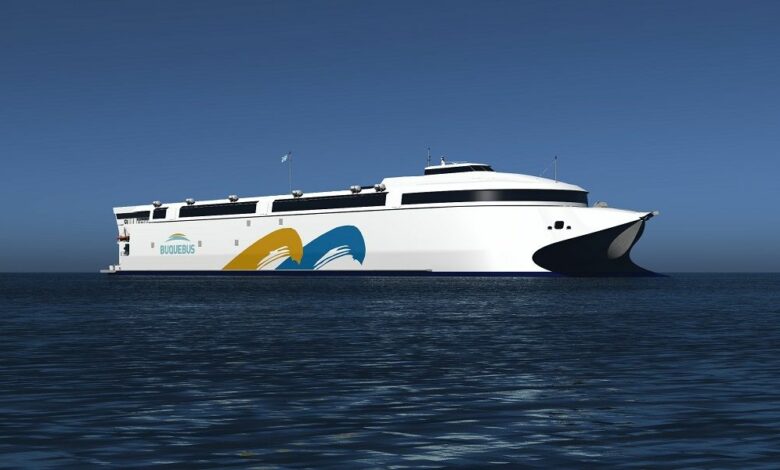World’s largest battery vessel gives shipping a glimpse of possible electric future

The world’s largest battery-driven ship is under construction in Australia, in a breakthrough for decarbonising global shipping. Tasmanian shipbuilder Incat is building a 130-m-long ropax ferry for delivery to South American operator, Buquebus, in 2025.
The uniquely designed vessel will be the largest ever of its type and also be the world’s first zero-emission, lightweight catamaran. It will be fully battery powered, with an eight-e-motor waterjet propulsion configuration from Finish technology group Wärtsilä and the largest ever power pack supplied by Norway-based maritime battery maker Corvus Energy.
Sporting more than 40 MWh, the battery modules and energy storage system package are said to be four times larger than on any electric/hybrid ship currently operating. The ship will also have the longest zero-emission journey at the highest speed, and it will be charged with the world’s highest capacity chargers.
“This groundbreaking project marks a turning point in the maritime industry’s effort to transition towards greener means of transportation. Combining cutting-edge technology, environmental consciousness, and innovative design, it redefines the future of ferry operations worldwide and paves the way for other large, zero-emission vessels,” said Halvard Hauso, commercial director for Europe at Corvus Energy.
Once delivered, the vessel will operate between Argentina and Uruguay, carrying up to 2,100 passengers and 225 vehicles. It will also be the first fully electric vessel in South America, Hauso noted, adding: “This project demonstrates that maritime decarbonisation is now happening worldwide, not only in Europe.”
The topic of batteries as a fuel source for shipping has been making a lot of headlines this year. Future prices of alternative green fuels may be a multiple of those of fossil fuels, while their availability is expected to continue to be low for some time. Energy-saving technologies such as batteries are seen as potential requirements to address the challenge and the International Maritime Organization’s Carbon Intensity Indicator targets.
Ships fitted with battery setups have already surpassed the 1,000 mark, according to class society DNV and the Maritime Battery Forum.
June’s edition of Splash Extra took a deep dive into what the future holds for batteries in larger ships, typically travelling further.
Despite the promising numbers, electric hybrid or pure electric propulsion is still in its infancy when it comes to shipping, with cost, safety, and fast charging of batteries remaining big hurdles to overcome. For charging batteries with shore power and sailing parts or whole distances on charged shore power, the energy density becomes a showstopper for 100% decarbonisation for most of shipping, Eirik Ovrum, principal consultant at class society DNV, told Splash Extra.
Geir Bjørkeli, chief executive of Corvus, also noted that batteries become “somewhat impractical” in terms of volume, weight, and price for longer distances. “While the technology exists to fully electrify any ship, it would require a significant amount of space, add substantial weight, and be costly for shipowners,” he acknowledged.
